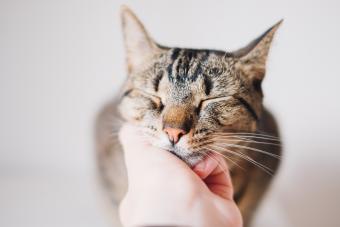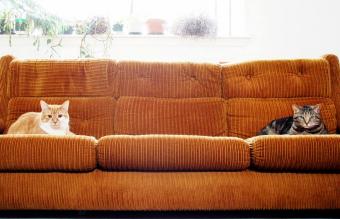
Our pets' tails are super cute, but they also have some important functions. Even if your tail-chasing kitten suggests otherwise, cats absolutely realize they have tails and instinctively control them to help with balance, communication, and gobs of other things. These floofy appendages are pretty darn fascinating. We’re breaking down everything you need to know about cat tails, including the good, the bad, and even the tailless.
1. Tails Help With Balance

Cats are known for being agile. Most can scale even the narrowest ledge, and they can do this thanks to their tail. They use their tail as a counterbalance while jumping or navigating narrow places. Watch your cat for a bit, and you’ll notice how they move their tail in the opposite direction to help them regain balance. It’s pretty cool!
2. Cats Use Tail Position to Communicate

Cats use tail positions and movements as a form of non-verbal communication. But it’s not just fellow cats that can read this language. You can, too! Depending on how they hold their tail, you can learn if your cat is happy, mad, annoyed, or excited.
3. Tails Also Keep Them Warm

Does your cat ever curl up in a ball with their tail wrapped around their body? They’re using their tail in a very intentional way: to stay warm! A cat’s body temperature is quite a bit higher than ours (100° to 102.5°F or 38° to 39° C, on average), and they just love staying toasty warm. Their wrapped tail can shield their face from harsh weather and keep their body temp up.
The average length of a cat’s tail is 10 inches (25.4 centimeters).
4. Tail Injuries Are Serious

Any injuries are serious, but tail injuries can have some pretty significant long-term effects. A cat’s tail is an extension of their spine, so it’s made up of tiny vertebrae. Unfortunately, cats can experience lasting nerve damage if the injury is bad enough or happens close to the base of the tail. This can result in problems with going to the bathroom or even paralysis. That’s why you should always see your vet for tail injuries.
5. A Cat’s Tail Can Fall Off

It’s gross but true: a cat’s tail can literally fall off. This doesn’t just happen spontaneously. There’s always trauma involved, like being hit by a car or an accidental tail-stuck-in-the-door situation. Unfortunately, tails can’t be reattached (at least not successfully), but most cats go on to live totally normal lives even after these tail avulsion injuries.
6. But They Don’t Need One to Survive

Cats don’t need a tail to survive. If they’re born without a tail or lose theirs at some point during their life, they’ll learn to adjust. Tailless cats reportedly don’t have any balance issues and have about the same agility as tailed cats!
7. Some Cat Breeds Are Naturally Tailless

There’s only one cat breed that’s truly tailless, which is the Manx. But a few other cat breeds have naturally short tails that look like little nubs. These are the American bobtail, Japanese bobtail, pixie-bob, Highlander, and Cymric.
Some cats have no tails, while others have super long ones. The longest recorded cat tail was a whopping 17.58 inches (44.65 centimeters)!
Sign up for our newsletter featuring all the latest stories and products we love.
8. Tail Twitching Could Point to a Problem

For the record, your cat definitely knows their tail is there. They’re aware of it, and it doesn’t sneak up on them. Playful kittens might chase their tail around as a game, but paying too much attention to their tail could point to a problem.
Cats with feline hyperesthesia syndrome, also known as “twitchy cat syndrome,” can suddenly attack their tail or experience excessive tail twitching. Fleas and skin allergies can also make cats gnaw on their tails.
A Tale About Cat Tails

Your cat’s tail does some pretty incredible things, like maintaining their balance, keeping them warm, and allowing them to communicate with you and other animals. Try to keep your cat out of risky situations where they could injure their tail. If they do sustain an injury, see your vet right away. But chances are, they’ll recover and do just fine for many more years.







